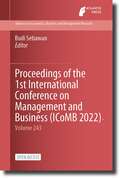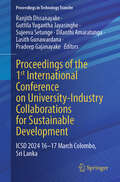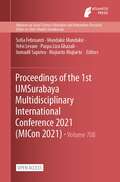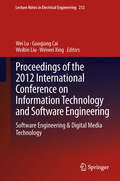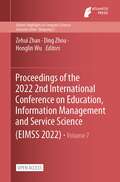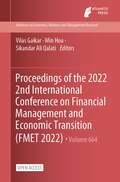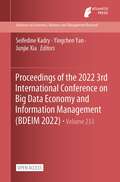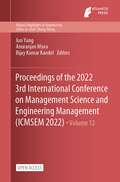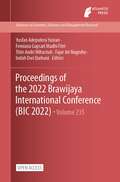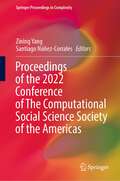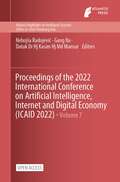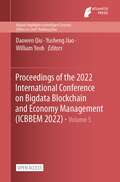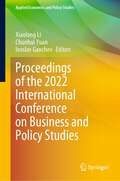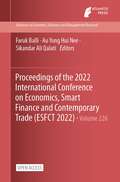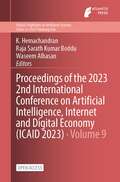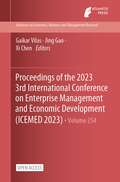- Table View
- List View
Proceedings of the 1st International Conference on Creativity, Technology, and Sustainability: CCTS 2024, 15–16 May, Jeddah, Saudi Arabia (Proceedings in Technology Transfer)
by Djihed Berkouk Uday Chatterjee Tallal Abdel Karim Bouzir Imed Ben DhaouThis open-access book presents peer-reviewed articles from the 1st International Conference on Creativity, Technology, and Sustainability (CCTS), held on May 15–16, 2024, at Dar Al-Hekma University in Jeddah, Saudi Arabia. It explores the dynamic interplay between technology and sustainability, emphasizing the need for advancements to align with Saudi Arabia's Vision 2030 and the United Nations Sustainable Development Goals (SDGs). The book includes case studies, literature reviews, and scientific works, organized into five main parts: Technology for Innovation and Safety, Sustainable Solutions for Technology and Infrastructure, Transforming Education and Social Impact, Sustainable Environment and Smart Cities, and Technologies for Health, Environment, and Sustainability. Readers will discover how technology fosters innovation, safety, and sustainability across various fields, aligning with specific UN SDGs. Practical applications highlight sustainability awareness and responsible behavior, facilitating knowledge transfer for the public sector, innovative companies, academia, and research centers. Targeting researchers, policymakers, sustainability advocates, and decision-makers committed to achieving the UN's SDGs and Saudi Vision 2030, this book identifies key areas for attention in architecture, design, social and environmental sciences, law, and business. It serves as a valuable guide for professionals in technology-driven sectors like Artificial Intelligence and the Internet of Things, emphasizing technology's vital role in addressing sustainability challenges, enhancing efficiency, promoting environmentally friendly processes, and reducing costs, ultimately improving the quality of life for all.
Proceedings of the 1st International Conference on Management and Business (Advances in Economics, Business and Management Research #243)
by Budi SetiawanThis is an open access book. Universitas Sarjanawiyata Tamansiswa proudly invites all students, researchers, lecturers, and practitioners to participate in the International Conference on Management and Business (ICoMB). This hybrid conference is a part of an annual event called International Management Week (IMW) hosted by Universitas Sarjanawiyata Tamansiswa will be held in Yogyakarta, Indonesia on October 31, 2022. The conference theme is Empowering Small and Medium Enterprises.ICoMB aims to provide a venue for scholars to share their knowledge in the field of management and business-related areas internationally through research and best practice outcomes presentation to promote learning from each other by exchanging insights and strengthening the network.
Proceedings of the 1st International Conference on University-Industry Collaborations for Sustainable Development: ICSD 2024 16–17 March Colombo, Sri Lanka (Proceedings in Technology Transfer)
by Ranjith Dissanayake Guttila Yugantha Jayasinghe Sujeeva Setunge Dilanthi Amaratunga Lasith Gunawardana Pradeep GajanayakeThis book includes peer reviewed articles from the 1st International Conference on University-industry Collaborations for Sustainable Development (ICSD 2024) under the themes of Student Employability, Blended Learning, Invention and Innovation, Technoentrepreneurial Skills, Curriculum Development, Multidisciplinary Joint Research, and other initiatives., etc. It highlights the latest knowledge of strategic university-industry partnerships in Asian universities and brings together academic and industry experts to exchange knowledge and foster collaboration.
Proceedings of the 1st International Hospitality, Travel and Event Conference (Advances in Economics, Business and Management Research #244)
by Derinta EntasThis is an open access book.Reinventing Hospitality, Travel, and Event for a Future DirectionThe tourism industry is an important sector in the world, particularly in terms of its ability to create jobs, generate income and contribute to people's well-being. While of its importance, the tourism industry is vulnerable to external disruptions. Historically, the tourism industry has been vulnerable to terrorist attacks, recessions, pandemics, natural disasters, and the effects of climate change. Such challenges have also forced the industry to accelerate innovation and transformation to survive and thrive. Technology and digitalization are more commonly used in businesses and organizations' operations. There are shifts in consumer behavior as a result of disruptions. Travelers demand safer products and services and more efficient ways to travel. New products and services emerge as a result of the disruptions, for example, trends in virtual conferences, cloud kitchens, staycations, and many more.
Proceedings of the 1st UMSurabaya Multidisciplinary International Conference 2021 (Advances in Social Science, Education and Humanities Research #708)
by Sofia Februanti Mundakir Mundakir Yelvi Levani Puspa Liza Ghazali Jumadil Saputra Mujiarto MujiartoThis is an open access book. Internationalization is one aspect of becoming qualified in this globalization era, especially for higher education levels. In this particular era when everyone is locked down due to Covid 19 Virus, the academic activity must still run. It is correlated with vision of Universitas Muhammadiyah Surabaya as an international standard university so that it can compete with universities at national or international level. During Pandemy, many obstacles occur then it is also led with many opportunities.
Proceedings of the 2012 International Conference on Information Technology and Software Engineering
by Guoqiang Cai Wei Lu Weibin Liu Weiwei XingProceedings of the 2012 International Conference on Information Technology and Software Engineering presents selected articles from this major event, which was held in Beijing, December 8-10, 2012. This book presents the latest research trends, methods and experimental results in the fields of information technology and software engineering, covering various state-of-the-art research theories and approaches. The subjects range from intelligent computing to information processing, software engineering, Web, unified modeling language (UML), multimedia, communication technologies, system identification, graphics and visualizing, etc. The proceedings provide a major interdisciplinary forum for researchers and engineers to present the most innovative studies and advances, which can serve as an excellent reference work for researchers and graduate students working on information technology and software engineering. Prof. Wei Lu, Dr. Guoqiang Cai, Prof. Weibin Liu and Dr. Weiwei Xing all work at Beijing Jiaotong University.
Proceedings of the 2020 Conference of The Computational Social Science Society of the Americas (Springer Proceedings in Complexity)
by Zining Yang Elizabeth Von BriesenThis book is comprised of the latest research into CSS methods, uses, and results, as presented at the 2020 annual conference of the Computational Social Science Society of the Americas (CSSSA). Computational social science (CSS) is the science that investigates social and behavioral dynamics through social simulation, social network analysis, and social media analysis. The CSSSA is a professional society that aims to advance the field of computational social science in all areas, including basic and applied orientations, by holding conferences and workshops, promoting standards of scientific excellence in research and teaching, and publishing research findings and results. The above-mentioned conference was held virtually, October 8 – 11, 2020. What follows is a diverse representation of new results and approaches to using the tools of CSS and agent-based modeling (ABM) in exploring complex phenomena across many different domains. Readers will therefore not only have the results of these specific projects upon which to build, along with a wealth of case-study examples that can serve as meaningful exemplars for new research projects and activities, they will also gain a greater appreciation for the broad scope of CSS.
Proceedings of the 2021 Conference of The Computational Social Science Society of the Americas (Springer Proceedings in Complexity)
by Zining Yang Elizabeth Von BriesenThis book contains a selection of the latest research in the field of Computational Social Science (CSS) methods, uses, and results, as presented at the 2021 annual conference of the Computational Social Science Society of the Americas (CSSSA). Computational social science (CSS) is the science that investigates social and behavioral dynamics through social simulation, social network analysis, and social media analysis. The CSSSA is a professional society that aims to advance the field of computational social science in all areas, including basic and applied orientations, by holding conferences and workshops, promoting standards of scientific excellence in research and teaching, and publishing research findings and results.
Proceedings of the 2022 2nd International Conference on Education, Information Management and Service Science (Atlantis Highlights in Computer Sciences #7)
by Zehui Zhan Ding Zhou Honglin WuThis is an open access book. 2022 2nd International Conference on Education, Information Management and Service Science (EIMSS 2022)was held on July 22–24, 2022 in Changsha, China. EIMSS 2022 is to bring together innovative academics and industrial experts in the field of Education, Information Management and Service Science to a common forum. The primary goal of the conference is to promote research and developmental activities in Education, Information Management and Service Science and another goal is to promote scientific information interchange between researchers, developers, engineers, students, and practitioners working all around the world. The conference will be held every year to make it an ideal platform for people to share views and experiences in Education, Information Management and Service Science and related areas.
Proceedings of the 2022 2nd International Conference on Financial Management and Economic Transition (Advances in Economics, Business and Management Research #664)
by Vilas Gaikar Min Hou Sikandar Ali QalatiThis is an open access book.As a leading role in the global megatrend of scientific innovation, China has been creating a more and more open environment for scientific innovation, increasing the depth and breadth of academic cooperation, and building a community of innovation that benefits all. Such endeavors are making new contributions to the globalization and creating a community of shared future. FMET is to bring together innovative academics and industrial experts in the field of Financial Management and Economic to a common forum. We will discuss and study about Financial marketing, Corporate finance, Management and administration of commercial Banks, International trade theory and practice, Economy and foreign economic management, Economic information management and other fields. FMET 2022 also aims to provide a platform for experts, scholars, engineers, technicians and technical R & D personnel to share scientific research achievements and cutting-edge technologies, understand academic development trends, expand research ideas, strengthen academic research and discussion, and promote the industrialization cooperation of academic achievements.To adapt to this changing world and China's fast development in the new era, 2022 2nd International Conference on Financial Management and Economic Transition to be held in August 2022. This conference takes "bringing together global wisdom in scientific innovation to promote high-quality development" as the theme and focuses on cutting-edge research fields including Financial Management and Economic Transition. FMET 2022 encourages the exchange of information at the forefront of research in different fields, connects the most advanced academic resources in China and the world, transforms research results into industrial solutions, and brings together talent, technology and capital to drive development. The conference sincerely invites experts, scholars, business people and other relevant personnel from universities, scientific research institutions at home and abroad to attend and exchange!
Proceedings of the 2022 3rd International Conference on Big Data Economy and Information Management (Advances in Economics, Business and Management Research #233)
by Seifedine Kadry Yingchen Yan Junjie XiaThis is an open access book.2022 3rd International Conference on Big Data Economy and Information Management (BDEIM 2022) will be held from December 2 to 3 in Zhengzhou, China. The conference is co-hosted by Henan University, Henan Academy of Sciences and Henan Association for Science and technology. It dedicates to create a platform for academic communications between specialists and scholars in the fields of Big Data Economy and Information Management. The conference will create a path to establish a research relation for the authors and listeners with opportunities for collaboration and networking among the universities and institutions for promoting research and developing technologies.
Proceedings of the 2022 3rd International Conference on E-commerce and Internet Technology (Atlantis Highlights in Engineering #11)
by Ziqiang Zeng Vilas Gaikar Reza LotfiThis is an open access book.Due to recent pandemic, the 2022 3rd International Conference on E-commerce and Internet Technology (ECIT 2022) which was planned to be held in Zhangjiajie, China, was held virtually online during March 4- 6, 2022. The decision to hold the virtual conference was made in compliance with many restrictions and regulations that were imposed by countries around the globe. Such restrictions were made to minimize the risk of people contracting or spreading the COVID-19 through physical contact. There were 90 individuals who attended this on-line conference, represented many countries including Singapore, USA, India and China. ECIT is to bring together innovative academics and industrial experts in the field of E-Commerce and Internet Technology to a common forum. The primary goal of the conference is to promote research and developmental activities in E-Commerce and Internet Technology. Another goal is to promote scientific information interchange between researchers, developers, engineers, students, and practitioners working all around the world. The conference will be held every year to make it an ideal platform for people to share views and experiences in E-Commerce and Internet Technology and related areas. During the conference, the conference model was divided into three sessions, including oral presentations, keynote speeches, and online Q&A discussion. The proceedings are a compilation of the accepted papers and represent an interesting outcome of the conference. Topics include but are not limited to the following areas: E-commerce and digital business, Information economy and enterprise management, Digital economy and artificial intelligence technology and Application and other related topic. All the papers have been through rigorous review and process to meet the requirements of international publication standard. We would like to acknowledge all of those who supported ECIT 2022. The help and contribution of each individual and institution was instrumental in the success of the conference.
Proceedings of the 2022 3rd International Conference on Management Science and Engineering Management (Atlantis Highlights in Engineering #12)
by Jun Yang Anuranjan Misra Bijay Kumar KandelThis is an open access book.Management science aims to study the dynamic study of human use of limited resources in management activities to achieve organizational goals: complex and innovative social behavior and its laws. And engineering management refers to the management of important and complex new products, equipment and devices in the process of development, manufacturing and production, and also includes the study and management of technological innovation, technological transformation, transformation, transformation, layout and strategy of industrial engineering technology development.The development or breakthrough of management theory is accompanied by the development and progress of science and technology, and the level of science and technology and the level of management theory in each historical period are mutually adaptive, and it can be said that the progress of science and technology plays an important role in promoting the development of management. At the same time, the rapid development and progress of science and technology give a strong injection to the development of engineering, and provide the possibility for engineering construction can use new technology, new equipment, new technology and new materials.Modern management is an important development direction of management science nowadays. And the use of modern management in engineering has an important role in saving social costs, ensuring project quality, and improving safety awareness and behaviorICMSEM 2022, in contrast to the previous two conferences, will focus its discussions on modern management, talking about the benefits that modernization brings to engineering and: Develop and advance management science through the study and application of certain issuesTo open up new perspectives in the sharing of speakers and inspire the audience to new ways of managing in engineering.To create a forum for sharing, research and exchange at the international level, so that the participants can be informed of the latest research directions, results and contents of management science, which will inspire them to new ideas for research and practice.Papers on management science and engineering management will be accepted and published in the form of conference proceedings for those who cannot attend the conference.
Proceedings of the 2022 6th International Seminar on Education, Management and Social Sciences (Advances in Social Science, Education and Humanities Research #687)
by Ghaffar Ali Mehmet Cüneyt Birkök Intakhab Alam KhanThis is an open access book. The aim of 2022 6th International Seminar on Education, Management and Social Sciences (ISEMSS 2022) is to bring together innovative academics and industrial experts in the field of Education, Management and Social Sciences to a common forum. The primary goal of the conference is to promote research and developmental activities in Education, Management and Social Sciences and another goal is to promote scientific information interchange between researchers, developers, students, and practitioners working all around the world. The conference will be held every year to make it an ideal platform for people to share views and experiences in Education, Management and Social Sciences and related areas.
Proceedings of the 2022 Brawijaya International Conference (Advances in Economics, Business and Management Research #235)
by Yusfan Adeputera Yusran Femiana Gapsari Madhi Fitri Titin Andri Wihastuti Fajar Ari Nugroho Indah Dwi QurbaniThis is an open access book.We proudly present the 2022 Brawijaya International Conference (BIC) as the consecutive series of conferences that is organised and hosted annually by Univeritas Brawijaya, Indonesia. The BIC 2022 will be held in Bali, Indonesia, on October 7 – 9, 2022. The conference committee consists of multi department of Univeritas Brawijaya. The BIC 2022 will present multidisciplinary research, community service essay and research, and industrial findings related to sustainable development. The BIC 2022 will be a great opportunity for exchanging ideas and knowledge in all multidisciplinary areas for academicians, scientists, practitioners, and global executives. The event will facilitate a focus group discussion and consultation for the participants, especially stakeholders, to address the current issues and challenges including the future invention and innovation within multidisciplinary areas.The BIC 2022 invites fellow researchers/scientists, students, practitioners, global executives from multidisciplinary areas to participate and gather in this event to share and discuss the related research result and finding from all multidisciplinary areas. You should not miss the great opportunity to establish partnership and acquire tremendous knowledge within the BIC 2022.
Proceedings of the 2022 Conference of The Computational Social Science Society of the Americas (Springer Proceedings in Complexity)
by Zining Yang Santiago Núñez-CorralesThis book contains a selection of the latest research in the field of computational social science (CSS) methods, uses, and results, as presented at the 2022 annual conference of the Computational Social Science Society of the Americas (CSSSA). Computational social science (CSS) is the science that investigates social and behavioral dynamics through social simulation, social network analysis, and social media analysis.The CSSSA is a professional society that aims to advance the field of computational social science in all areas, including basic and applied orientations, by holding conferences and workshops, promoting standards of scientific excellence in research and teaching, and publishing research findings and results.
Proceedings of the 2022 International Conference on Artificial Intelligence, Internet and Digital Economy (Atlantis Highlights in Intelligent Systems #7)
by Nebojša Radojević Gang Xu Datuk Dr Hj Kasim Hj Md MansurThis is an open access book.With the continuous upgrading of network information technology, especially the combination of information technology such as Internet - cloud computing - blockchain - Internet of Things and in social and economic activities, through artificial intelligence, Internet and big data with high quality and fast processing efficiency improvement, economic form from industrial economy to information economy. This will greatly reduce social transaction costs, improve the efficiency of resource optimization, increase the added value of products, enterprises and industries, and promote the rapid development of social productivity. The 2022 International Conference on Artificial Intelligence, Internet and Digital Economy (ICAID 2022) will focus on the latest research on "Artificial Intelligence, Internet and Digital Economy", which brings together experts, scholars, researchers and related practitioners from around the world to share research results, discuss hot issues, and provide attendees with cutting-edge technology information to keep them abreast of industry developments, the latest technologies, and broaden their research horizons.
Proceedings of the 2022 International Conference on Bigdata Blockchain and Economy Management (Atlantis Highlights in Intelligent Systems #5)
by Daowen Qiu Yusheng Jiao William YeohThis is an open access book.As a leading role in the global megatrend of scientific innovation, China has been creating a more and more open environment for scientific innovation, increasing the depth and breadth of academic cooperation, and building a community of innovation that benefits all. These endeavors have made new contribution to globalization and creating a community of shared future.With the rapid development of modern economic society, in the process of economic management, informatization has become the mainstream of economic development in the future. At the same time, with the emergence of advanced management technologies such as blockchain technology and big data technology, real market information can be quickly obtained in the process of economic management, which greatly reduces the operating costs of the market economy and effectively enhances the management level of operators, thus contributing to the sustained, rapid and healthy development of the market economy. Under the new situation, the innovative application of economic management research is of great practical significance. 2022 International Conference on Bigdata, Blockchain and Economic Management (ICBBEM 2022) will be held on March 25–27, 2022 in Wuhan, China. ICBBEM 2022 will focus on the latest fields of Bigdata, Blockchain and Economic Management to provide an international platform for experts, professors, scholars and engineers from universities, scientific institutes, enterprises and government-affiliated institutions at home and abroad to share experiences, to expand professional fields, to exchange new ideas face to face, to present research results, and to discuss the key challenging issues and research directions facing the development of this field, with a view to promoting the development and application of theories and technologies in universities and enterprises.
Proceedings of the 2022 International Conference on Business and Policy Studies (Applied Economics and Policy Studies)
by Xiaolong Li Chunhui Yuan Ivoslav GanchevThis proceedings volume contains papers accepted by the 2022 International Conference on Business and Policy Studies (CONF-BPS 2022), which are carefully selected and reviewed by professional reviewers from corresponding research fields and the editorial team of the conference. This volume presents latest research achievements, inspirations, and applications in applied economy, finance, enterprise management, public administration, and policy studies. CONF-BPS hopes this volume could be inspiring and of academic value.Business and policy studies both are heated research topics and are related to multiple fields. Held by Eliwise Academy, CONF-BPS aims at bringing together intellectuals from related fields including applied economy, finance, and public administration for academic exchange. Its goal is to serve as an international platform for researchers to present latest research progress, share ideas and inspirations, and exchange experience. Through more academic communication and exchange, this conference hops to promote international corporation and joint initiatives in relevant fields. This volume will be of interest to researchers, academics, professionals, and policy makers in the field of business, economics, management, and policy studies.
Proceedings of the 2022 International Conference on Economics, Smart Finance and Contemporary Trade (Advances in Economics, Business and Management Research #663)
by Faruk Balli Au Yong Hui Nee Sikandar Ali QalatiThis is an open access book.As a leading role in the global megatrend of scientific innovation, China has been creating a more and more open environment for scientific innovation, increasing the depth and breadth of academic cooperation, and building a community of innovation that benefits all. Such endeavors are making new contributions to the globalization and creating a community of shared future.To adapt to this changing world and China's fast development in the new era, The 2022 International Conference on Economics, Smart Finance and Contemporary Trade to be held in July 2022. This conference takes "bringing together global wisdom in scientific innovation to promote high-quality development" as the theme and focuses on cutting-edge research fields including Economics, Smart Finance and Contemporary Trade. This conference aims to boost development of the Greater Bay Area, expand channels of international academic exchange in science and technology, build a sharing platform of academic resources, promote scientific innovation on the global scale, strengthen academic cooperation between China and the outside world, enhance development of new energy and materials and IT, AI, and biomedicine industries. It also aims to encourage exchange of information on frontiers of research in different areas, connect the most advanced academic resources in China and the world, turn research results into industrial solutions, and bring together talents, technologies and capital to boost development.
Proceedings of the 2022 International Symposium on Energy Management and Sustainability: ISEMAS 2022 (Springer Proceedings in Energy)
by M. Ziya Sogut T. Hikmet Karakoc Omer Secgin Alper DalkiranThe International Symposium on Energy Management and Sustainability (ISEMAS) is a multi-disciplinary symposium that presents research on current issues in energy efficiency, social awareness, and global climate change. The conference provides a platform offering insights on the latest trends and innovations in energy management and the impact of sustainability on energy management processes. In this context, it aims to bring together sectoral, scientific, and demand-related elements in the field of energy. ISEMAS allows researchers, scientists, engineers, practitioners, policymakers, and students to exchange information, present new technologies and developments, and discuss future direction, strategies and priorities that improve environmental sustainability.
Proceedings of the 2023 2nd International Conference on Artificial Intelligence, Internet and Digital Economy (Atlantis Highlights in Intelligent Systems #9)
by K. Hemachandran Raja Sarath Kumar Boddu Waseem AlhasanThis is an open access book. With the continuous upgrading of network information technology, especially the combination of Internet - cloud computing - blockchain - Internet of things and other information technologies with social and economic activities, through the improvement of artificial intelligence, Internet and big data with high quality and fast processing efficiency, the economic form is transformed from industrial economy to information economy. This will greatly reduce social transaction costs, improve the efficiency of resource optimization, increase the added value of products, enterprises and industries, and promote the rapid development of social productivity. 2023 2nd International Conference on Artificial Intelligence, the Internet and the Digital Economy (ICAID 2023) will continue to focus on the latest research on "Artificial intelligence, the Internet and the Digital Economy", and expand the research on "technology and application of the integrated development of Digital Economy and Artificial Intelligence" as the theme. The aim is to gather experts, scholars, researchers and related practitioners from around the world to share research results, discuss hot issues, and provide participants with cutting-edge technology information so that they can keep abreast of industry developments, the latest technologies and broaden their research horizons.The conference was held in Beijing, China on April 21-23, 2023. All experts and scholars are welcome to attend.
Proceedings of the 2023 2nd International Conference on Urban Planning and Regional Economy (Advances in Economics, Business and Management Research #253)
by Reza Lotfi Chukwunonso Kelvin Oraedu Ferdous AhmedThis is an open access book.As a leading role in the global megatrend of scientific innovation, China has been creating a more and more open environment for scientific innovation, increasing the depth and breadth of academic cooperation, and building a community of innovation that benefits all. These endeavors have made new contribution to globalization and creating a community of shared future.To adapt to this changing world and China's fast development in this new era, 2023 2nd International Conference on Urban Planning and Regional Economy (UPRE 2023) is to be held on April 21-23, 2023 in Beijing, China. Urban planning can change the functional structure of a city. Urban planning plays a very important role in regional economic development. Urban planning contains various factors of urban economic development. Urban economic development can effectively improve the speed and quality of urban planning formulation and implementation. The two affect and interact with each other. The meeting will focus on "urban planning" and "regional economy", and discuss their interdependence, mutual promotion and mutual restriction.UPRE 2023 aims to build a platform for scholars to discuss the relationship between urban planning and economy, aims to promote the exchange of different cutting-edge research in the field of information and connection at home and abroad the most advanced academic resources. Conference topics include Traffic management and supply chain, regional policy and local economic transformation, Scenic spot development and tourism economy, Urban modernization and high-tech economy, Environmental protection and sustainable economy, Resource development and industrial structure.
Proceedings of the 2023 3rd International Conference on Enterprise Management and Economic Development (Advances in Economics, Business and Management Research #254)
by Gaikar Vilas Jing Gao Xi ChenThis is an open access book.2023 3rd International Conference on Enterprise Management and Economic Development (ICEMED2023) will be held in Xi'an, China on May 12–14, 2023.Enterprise management is the general term for a series of functions such as organizing, planning, commanding, supervising and regulating the production and operation activities of enterprises.Relative to economic growth, economic development is the core concept of development economics. Economic development refers to the high-quality development of the economy, including quality and quantity, rather than merely the growth of quantity.Enterprise management covers economics, management, business management, financial management, human resource management and other aspects, and is a comprehensive interdisciplinary science that spans natural science, engineering science, technical science and humanities and social science. Enterprise management comes into being with the development of modern socialized mass production. The use of modern management means and methods to manage enterprises, ensure the survival and development of enterprises, and play a positive role in promoting economic development.ICEMED2023 will bring together experts and scholars from relevant fields to discuss the relationship between enterprise management and economic development. Reasonable enterprise management is an important way to promote the economic development of enterprises. Scientific and reasonable use of industrial and commercial enterprise management knowledge can reasonably carry out effective macro-control on the enterprise economy and ensure the stable progress and development of the enterprise economy.
Proceedings of the 2023 4th International Conference on Education, Knowledge and Information Management (Atlantis Highlights in Computer Sciences #13)
by Xueming Yuan Yohannes Kurniawan Zhenyan JiThis is an open access book.With the successful experience of the past 3 years, we believe that the 2023 4th International Conference on Education, Knowledge and Information Management (ICEKIM 2023) will be an even greater success in 2023, and welcome all scholars and experts to submit their papers for the conference!The 2023 4th International Conference on Education, Knowledge and Information Management (ICEKIM 2023) will be held on January 13-15, 2023 in Zhengzhou, China. In the era of information explosion, there is no doubt that education is an important way of knowledge production, dissemination and diffusion. Education plays an important role in promoting human development and promoting the development of society and human knowledge. ICEKIM 2023 is to bring together innovative academics and industrial experts in the field of Education, Knowledge and Information Management to a common forum. The primary goal of the conference is to promote research and developmental activities in Education, Knowledge and Information Management and another goal is to promote scientific information interchange between researchers, developers, engineers, students, and practitioners working all around the world. The conference will be held every year to make it an ideal platform for people to share views and experiences in international conference on Education, Knowledge and Information Management and related areas.

